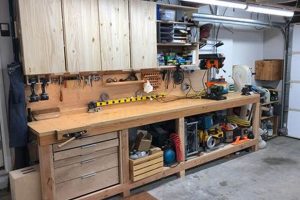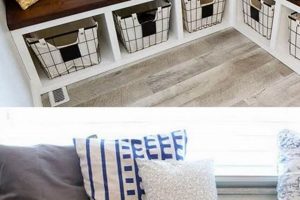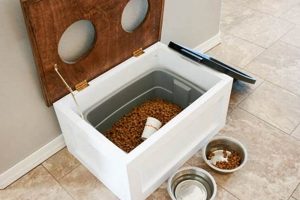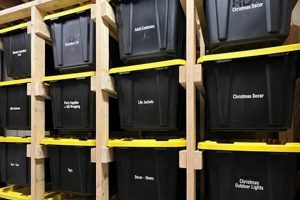Independent construction of shelving or organizational systems for preserving canned goods is a practical approach to household provisioning. This method involves utilizing readily available materials and personal ingenuity to create structures that efficiently store and manage canned food items, thereby maximizing pantry space and facilitating inventory control. A simple example includes repurposing wooden pallets to build a tiered rack system within a basement or garage.
The practice offers several advantages, including cost-effectiveness, customization, and enhanced food security. By constructing individualized storage solutions, individuals can tailor systems to fit specific spatial constraints and aesthetic preferences, reducing reliance on commercially manufactured products. Historically, self-reliance in food preservation and storage has been a key component of household sustainability, providing a buffer against economic fluctuations and supply chain disruptions.
The subsequent sections will delve into various design considerations, material selection, construction techniques, and best practices for ensuring the longevity and safety of self-made canned food storage solutions. Considerations will include load bearing capacity, environmental control, and accessibility of stored items.
DIY Can Food Storage
The following tips outline crucial considerations for effective and safe construction of can food storage systems. Adherence to these guidelines will promote longevity, accessibility, and optimal organization of stored provisions.
Tip 1: Material Selection: Prioritize robust materials with adequate load-bearing capacity. Solid wood, heavy-duty metal shelving, or reinforced plastic are preferable. Avoid materials prone to moisture damage or pest infestation.
Tip 2: Structural Integrity: Ensure that the constructed framework is stable and securely anchored. Implement cross-bracing for shelving units, particularly those exceeding three feet in height. Distribute weight evenly to prevent collapse.
Tip 3: Environmental Control: Position storage solutions in cool, dry locations away from direct sunlight and sources of heat. Elevated temperature and humidity can degrade canned goods, reducing their shelf life.
Tip 4: Accessibility and Inventory: Design the storage system to facilitate easy access and visual inspection of all canned items. Implement a “first-in, first-out” (FIFO) rotation system to minimize spoilage and ensure utilization of older stock.
Tip 5: Weight Distribution: Heavier cans should be stored on lower shelves to maintain stability and reduce the risk of top-heaviness. Avoid overloading individual shelves beyond their specified weight limit.
Tip 6: Pest Prevention: Regularly inspect the storage area for signs of pests such as rodents or insects. Seal any cracks or crevices that could serve as entry points and consider using pest-resistant materials in construction.
Tip 7: Clear Labeling: Implement a clear labeling system to easily identify the contents and expiration dates of canned goods. This will streamline inventory management and minimize waste.
Implementing these tips will contribute to a safer, more efficient, and more durable DIY can food storage solution, optimizing long-term food preservation and accessibility.
The final section will provide a summary of key considerations and offer guidance on maintaining the storage system for optimal performance.
1. Space Optimization
Efficient utilization of available space is paramount in the context of DIY canned food storage. Proper planning and execution enable maximization of storage capacity within existing spatial constraints, thereby enhancing household resource management.
- Vertical Storage Utilization
Vertical space often remains underutilized. DIY solutions facilitate the construction of shelving units that extend upwards, maximizing cubic footage. For example, a narrow pantry can be significantly expanded by building shelves reaching from floor to ceiling. This approach allows for increased storage volume within the same footprint.
- Custom-Fit Dimensions
Pre-fabricated storage solutions may not perfectly align with available spaces, leading to inefficiencies. DIY approaches permit the creation of storage systems with dimensions tailored to specific alcoves, corners, or unconventional areas. This precision ensures that no usable space is wasted, resulting in a more streamlined and organized storage arrangement.
- Repurposed Materials and Adaptive Designs
DIY can food storage leverages repurposed materials, such as reclaimed wood or discarded shelving units, minimizing waste and promoting resourcefulness. The inherent flexibility of DIY allows for adapting designs to accommodate unique spatial challenges, like sloped ceilings or irregular wall configurations, effectively converting otherwise unusable areas into functional storage spaces.
- Under-utilized area
An under-utilized area in diy can food storage can be a game changer such as under the stairs, that space can be a perfect opportunity for food storage if you build it yourself
The above space optimizations highlight the value of a do-it-yourself approach to canned food storage. By maximizing spatial efficiency through vertical integration, custom designs, and repurposed materials, individuals can establish organized and effective storage solutions, regardless of spatial limitations.
2. Load Bearing
Load bearing is a critical consideration in the design and construction of DIY can food storage systems. The structural integrity of any such system is fundamentally dependent on its capacity to safely support the cumulative weight of stored canned goods. A failure to adequately account for load bearing can result in structural compromise, potentially leading to collapse and loss of inventory.
- Material Selection and Load Capacity
The choice of materials directly dictates the load-bearing capabilities of the storage system. Wood, metal, and reinforced plastics each possess distinct strength characteristics. For instance, solid hardwood can typically support significantly more weight than lightweight particleboard. Selecting materials appropriate for the intended load is paramount to preventing structural failure. Manufacturers’ specifications for material load limits should be consulted whenever possible.
- Shelf Span and Support Structure
The distance between support structures (e.g., shelf brackets, vertical supports) influences the load a shelf can safely bear. Increasing the span between supports reduces the maximum weight a shelf can hold without deflecting or breaking. Reinforcing shelf spans with additional supports or using thicker materials can mitigate this effect. A well-designed system distributes the load evenly across multiple supports to minimize stress on individual components.
- Joint Strength and Fasteners
The strength of connections between structural elements, such as shelves and vertical supports, is crucial. Weak joints can become points of failure under load. Employing appropriate fasteners, such as screws, bolts, or nails, suitable for the materials being joined is essential. Additionally, adhesives can enhance joint strength in some applications. The type of joint (e.g., butt joint, mortise and tenon) also affects its load-bearing capacity.
- Foundation and Weight Distribution
The foundation upon which the storage system rests must be capable of supporting the system’s total weight. Uneven or unstable foundations can induce stress on the structure, leading to deformation or collapse. Distributing the load evenly across the foundation is critical. This can be achieved by using a solid base or by employing leveling feet to ensure that the weight is distributed equally across all support points.
Adequate consideration of load-bearing principles is not merely a matter of convenience; it is a safety imperative in DIY can food storage construction. Proper material selection, structural design, and foundation preparation are essential to ensuring a stable and reliable storage system capable of safely supporting the weight of canned goods over an extended period. Failure to address these considerations adequately can lead to costly damage and potential injury.
3. Environmental Control
Environmental control represents a fundamental consideration in the realm of DIY can food storage. The longevity and safety of preserved goods are intrinsically linked to the ambient conditions within the storage environment. Maintaining optimal temperature and humidity levels is crucial for inhibiting spoilage and preserving nutritional value.
- Temperature Stability
Elevated temperatures accelerate degradation processes in canned goods, potentially leading to changes in flavor, texture, and nutritional content. Fluctuations in temperature can also compromise the integrity of can seals, increasing the risk of spoilage. Ideal storage temperatures generally range between 50F (10C) and 70F (21C). DIY can food storage designs should prioritize locations with stable temperatures, away from direct sunlight, heat sources (ovens, radiators), and uninsulated exterior walls. For example, basements or interior pantries often provide more stable temperature conditions compared to garages or attics.
- Humidity Regulation
High humidity levels promote corrosion of metal cans, leading to rust formation and potential compromise of the can’s seal. Conversely, excessively dry conditions can desiccate paper labels, making inventory management more difficult. Maintaining moderate humidity levels (around 15%-60% relative humidity) is advisable. Implementing vapor barriers or using desiccant materials in storage areas can help regulate humidity levels. An example of practical implementation includes the use of a dehumidifier in a basement storage area to mitigate humidity-induced corrosion.
- Light Exposure Mitigation
Direct exposure to sunlight can accelerate the degradation of certain canned goods, particularly those containing light-sensitive compounds. Furthermore, ultraviolet (UV) radiation can degrade packaging materials, such as labels and can coatings. DIY storage solutions should prioritize locations shielded from direct sunlight or employ light-blocking materials (e.g., opaque containers, window coverings) to minimize UV exposure. Storing canned goods within enclosed cabinets or pantries effectively mitigates the detrimental effects of light exposure.
- Air Circulation and Ventilation
Adequate air circulation within the storage area helps to prevent the formation of localized temperature and humidity pockets, which can accelerate spoilage. Proper ventilation also helps to dissipate any accumulated odors or moisture. DIY storage designs should incorporate features that promote air circulation, such as spacing between shelves and the use of perforated containers. For instance, incorporating wire mesh shelves instead of solid shelves allows for greater air movement around the canned goods.
In summation, careful attention to environmental control factors is essential for maximizing the shelf life and maintaining the quality of canned goods stored within DIY systems. Implementing strategies to regulate temperature, humidity, light exposure, and air circulation will contribute significantly to the effectiveness and safety of DIY can food storage solutions, reducing waste and ensuring the long-term availability of preserved food resources.
4. Accessibility
Accessibility is a pivotal attribute of effective DIY canned food storage systems. The ease with which stored items can be located, retrieved, and rotated directly influences the system’s utility and contribution to efficient food management.
- Visibility and Organization
Clear visibility of stored items is essential for effective inventory management. DIY systems can be designed to maximize visual access to canned goods, utilizing open shelving or transparent containers. Organizational strategies, such as categorization by food type or expiration date, further enhance accessibility. For example, arranging cans with labels facing outwards on tiered shelving allows for quick identification of contents and expiration dates, facilitating informed meal planning and minimizing waste.
- Reach and Ergonomics
The physical act of accessing canned goods should be ergonomically sound to prevent strain or injury. Shelf heights should be optimized to minimize bending, stretching, or reaching. Heavy items should be stored on lower shelves to reduce the risk of lifting injuries. DIY systems can be tailored to individual physical capabilities, incorporating features such as pull-out shelves or adjustable shelf heights to enhance ease of use. A system designed with shelves at waist height for a person with limited mobility exemplifies this principle.
- Rotation and Stock Management
A well-designed DIY system facilitates efficient stock rotation, ensuring that older items are used before newer ones to minimize spoilage. Implementing a “first-in, first-out” (FIFO) system is crucial. This can be achieved through various design features, such as designated loading and unloading zones or the use of gravity-fed shelving. A practical example involves using a shelving unit with a slight incline, allowing cans to automatically roll forward as older items are removed, ensuring the consistent use of older stock first.
- Labeling and Identification
Clear and consistent labeling is paramount for easy identification of canned goods, especially when dealing with a diverse inventory. DIY systems can incorporate standardized labeling schemes, utilizing color-coded labels or detailed inventory lists. This simplifies the process of locating specific items and reduces the risk of accidentally using expired products. Implementing a system where each shelf is labeled with the food category and expiration date range provides a clear overview of the available stock.
In conclusion, accessibility in DIY can food storage transcends mere convenience; it is an integral component of effective food management and safety. By prioritizing visibility, ergonomics, stock rotation, and labeling, individuals can create systems that are not only efficient but also contribute to minimizing waste and ensuring the optimal utilization of stored resources.
5. Material Durability
Material durability is a cornerstone of effective DIY can food storage systems. The longevity and structural integrity of self-constructed storage depend directly on the resilience of the materials employed. A causal relationship exists: selecting durable materials directly translates to an extended lifespan and reduced maintenance requirements for the storage solution. For instance, using untreated softwood for shelving in a humid basement will invariably lead to rot and eventual structural failure, necessitating costly repairs or replacement. In contrast, employing treated lumber or metal shelving significantly enhances resistance to moisture, pests, and physical stress, ensuring long-term stability. This understanding has practical significance: informed material choices minimize the risk of collapse, prevent food spoilage due to structural failure, and ensure the safety of individuals accessing the storage.
Practical application of material durability principles extends beyond simple material selection. It encompasses construction techniques and environmental considerations. For example, using corrosion-resistant fasteners, such as stainless steel screws, when assembling a metal shelving unit in a garage exposed to road salt spray significantly mitigates the risk of rust and structural weakening. Similarly, applying a sealant or waterproof coating to wooden components provides an additional layer of protection against moisture damage. The proper implementation of these techniques, coupled with appropriate material choices, ensures that the DIY storage solution can withstand the rigors of its environment and maintain its structural integrity over time. Considering load, environment and construction is important.
In summary, material durability is not merely a desirable feature, but a necessity for functional DIY can food storage. It directly impacts the system’s lifespan, safety, and overall effectiveness. Challenges may arise in balancing durability with cost and aesthetic considerations, but prioritizing long-term resilience over short-term savings is crucial. The long term costs always outweight the short term, if the materials are not durable. Linking back to the broader theme of efficient food management, a durable storage system contributes to minimizing food waste, optimizing resource utilization, and promoting household food security.
Frequently Asked Questions
The following questions address common concerns and practical considerations associated with the construction and maintenance of self-made canned food storage systems.
Question 1: What are the primary risks associated with inadequate load-bearing capacity in a DIY can food storage system?
Insufficient load-bearing capacity poses a significant risk of structural collapse. This can result in damage to stored goods, potential injury to individuals accessing the storage, and costly repairs or replacement of the system.
Question 2: How does humidity impact the longevity of canned goods stored in a self-built system?
Elevated humidity levels promote corrosion of metal cans, potentially compromising their structural integrity and leading to spoilage. Conversely, low humidity can damage paper labels, hindering inventory management. Maintaining appropriate humidity levels is crucial.
Question 3: What are the key considerations for selecting materials for a durable DIY can food storage system?
Material selection should prioritize strength, resistance to moisture and pests, and long-term stability. Solid wood, treated lumber, heavy-duty metal, and reinforced plastics are commonly used materials, each with its own advantages and disadvantages. Consult manufacturer guidelines for load-bearing specifications.
Question 4: Why is a “first-in, first-out” (FIFO) system important in managing canned goods stored in a DIY setup?
Implementing a FIFO system minimizes the risk of spoilage and ensures that older items are used before newer ones. This prevents food waste and maximizes the utilization of stored resources.
Question 5: What are the recommended strategies for preventing pest infestations in a DIY can food storage area?
Regularly inspect the storage area for signs of pests. Seal any cracks or crevices that could serve as entry points. Consider using pest-resistant materials in construction and employ appropriate pest control measures as needed.
Question 6: How can temperature fluctuations negatively affect the quality of canned goods in a self-made storage system?
Temperature fluctuations, particularly exposure to high temperatures, can accelerate the degradation of canned goods, affecting their flavor, texture, and nutritional value. Consistent temperature control is essential.
In summary, these frequently asked questions underscore the importance of careful planning, material selection, and environmental control in DIY can food storage. Adhering to these guidelines will promote safety, efficiency, and long-term preservation of stored provisions.
The subsequent section will provide a comprehensive checklist for ensuring the structural integrity and operational effectiveness of a DIY can food storage system.
DIY Can Food Storage
This exploration has detailed the critical elements of diy can food storage. Emphasis has been placed on material selection, load-bearing capacity, environmental control, accessibility, and long-term durability. Success in implementing such systems depends on diligent adherence to these principles, ensuring both the safety of the structure and the preservation of stored resources.
The construction of diy can food storage solutions presents a tangible opportunity to enhance household resilience and promote responsible resource management. The long-term benefits, when properly executed, far outweigh the initial investment of time and materials. Continued vigilance in maintenance and adherence to safety guidelines will maximize the return on that investment, securing a reliable food supply for the future.







